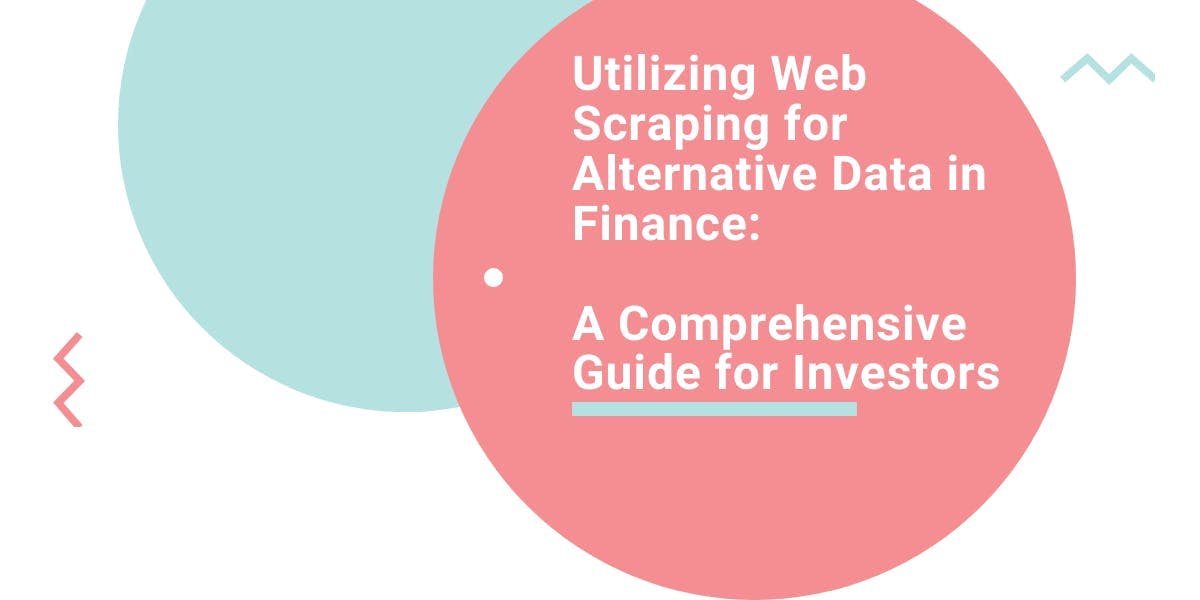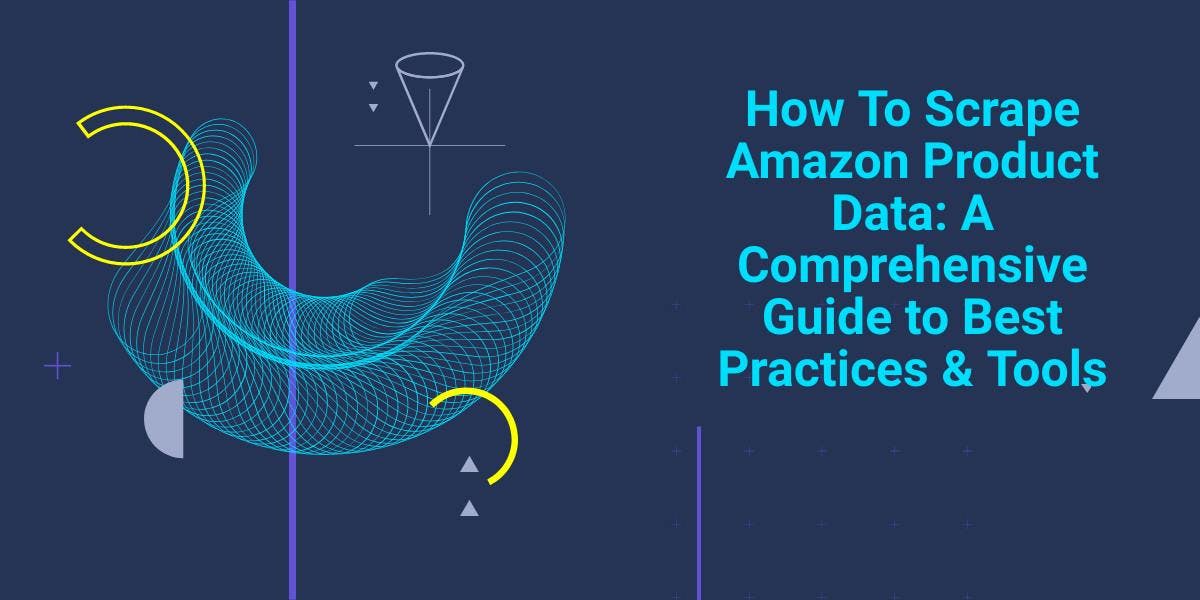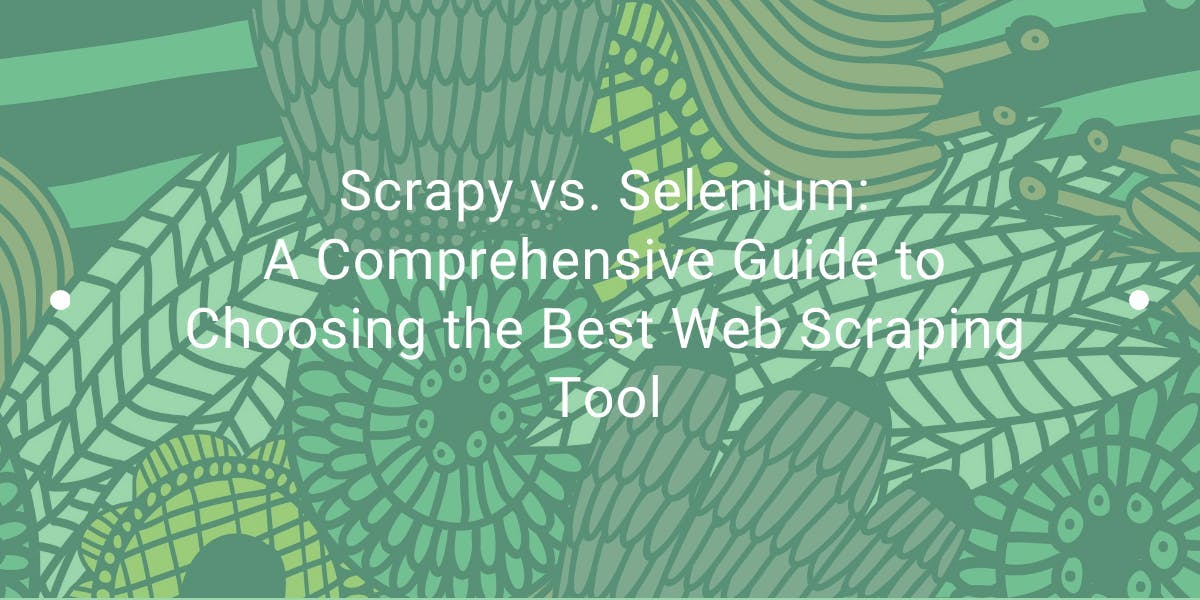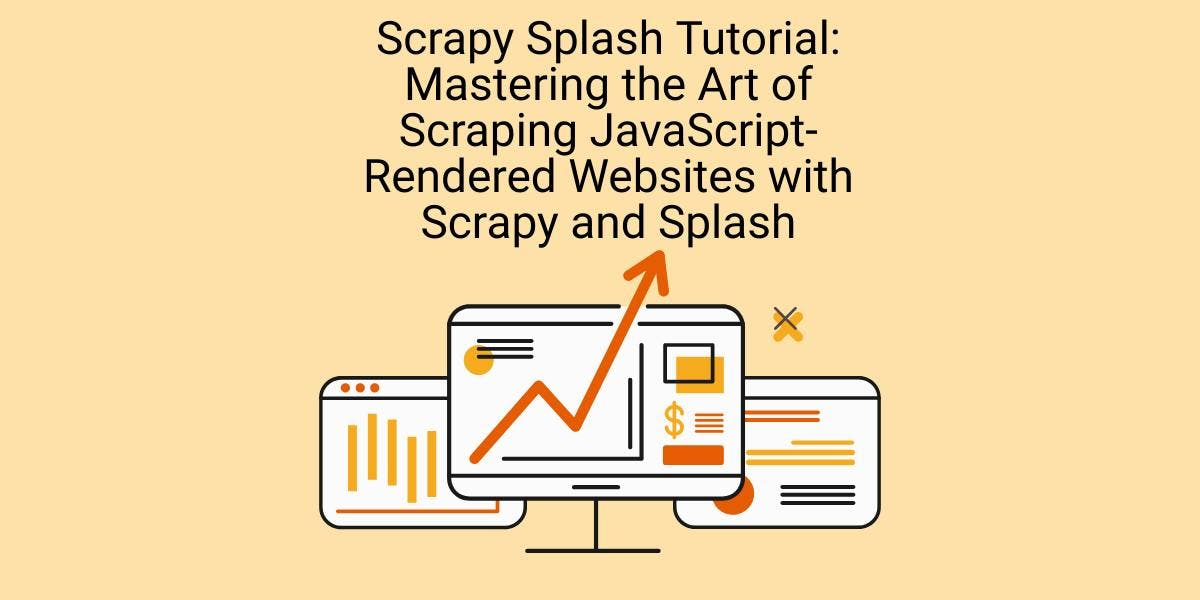Utilizing Web Scraping for Alternative Data in Finance: A Comprehensive Guide for Investors
Mihnea-Octavian Manolache on Aug 10 2023

Alternative data is not merely a buzzword; it has become a pivotal component in the world of finance, acting as a beacon for investors seeking innovative and insightful ways to guide their investment strategies. This term encompasses a broad spectrum of unconventional and non-traditional data sets that provide unique perspectives beyond traditional financial metrics.
The rise of alternative data has been nothing short of meteoric. A report from the Alternative Investment Management Association (AIMA) in collaboration with fintech heavyweight SS&C revealed that the current landscape boasts over 400 active providers of alternative data. This is an exponential increase from just 20 in 1990, marking a twentyfold growth over three decades.
Investment firms have not been blind to this surge. Approximately 50% of these firms are now integrating alternative data into their decision-making processes, as substantiated by both the AIMA report and a survey conducted by Bank of America. This adoption rate is poised to climb even higher, with technological investments spurring the trend.
A separate survey by AIMA, in association with legal experts Simmons & Simmons and Seward & Kissel, highlighted that 34% of hedge fund managers are newly investing in alternative data. This is a telling indicator of the growing trust and reliance on these unconventional information sources.
Understanding Alternative Data
Alternative data can be understood as an ever-evolving collection of information culled from non-traditional sources, carefully harnessed by investment firms to gain a competitive edge in the market. It is a dynamic and fluid category that encapsulates various forms of unconventional data. As opposed to the structured financial statements and market analyses commonly used in the financial sector, alternative data digs deeper, tapping into novel and untapped streams of information.
Constant Evolution and Adaptation
Providers of alternative data are relentless in their pursuit of new and innovative data sources. They continually explore the landscape, identifying fresh and unexplored streams of data that could reveal insights into market trends, consumer behavior, or potential investment opportunities. The boundaries of what constitutes alternative data are continually shifting and expanding, making it an ever-growing and intriguing field.
Examples and Applications
Consider the example of newcomer sites tracking trading disclosures made by members of Congress, or viral TikTok accounts amplifying this information. These platforms are functioning as an essential source of alternative data. Surprisingly, this is not dissimilar in concept from established categories like government contract data, which has long been considered part of the alternative data landscape.
Such diversity in sources offers multifaceted perspectives, from tracking political influences on the market to understanding shifts in consumer sentiment through social media platforms.
A Blend of the Novel and the Established
The beauty of alternative data lies in its flexible and inclusive nature. Whether it's the cutting-edge utilization of social media trends or the analysis of traditional government contracts, all these various facets coalesce into a robust and intricate picture of the market. This blend of the novel and the established broadens the horizon for investment firms, enabling them to unearth opportunities and risks that might otherwise remain obscured.
Challenges and Opportunities
While the fluidity and dynamism of alternative data offer vast opportunities, they also present challenges. Constant adaptation and integration of new data streams require robust technological support, ethical considerations, and strategic alignment. Navigating these complex terrains requires skill, foresight, and a willingness to embrace innovation.
Alternative data stands as a symbol of the investment industry's embrace of the unconventional and the readiness to transcend traditional boundaries. With its kaleidoscopic array of sources and an unceasing hunger for innovation, it's poised to continue reshaping investment strategies, offering a tantalizing glimpse into the future of finance. It's not just about numbers and trends; it's about the narrative behind those figures, a narrative that's as rich and varied as the data itself.
Exploring the Types of Alternative Data
In the modern investment landscape, alternative data serves as a treasure trove of insights, uncovering signals and patterns hidden in unconventional information streams. From tracking web users to monitoring private jet flights, here are some of the more prevalent types of alternative data employed in the finance sector:
Web Traffic and App Usage Analytics
Understanding the digital footprints of users can unveil significant trends and potential market moves.
Insights & Applications: Traders can gauge a software company's growth by monitoring user acquisition or attrition. Sudden surges in web traffic for specific product categories can signal emerging trends.
Key Players: SimilarWeb, a notable alternative data company, offers comprehensive data covering 1 billion sites and 8 million apps. In May 2021, it went public, expanding beyond its hedge fund client base, marking a significant milestone for the industry.
Social Sentiment and Product Reviews Monitoring
Social media and online product reviews are rich sources of public perception and sentiment, which can influence trading decisions.
Use Cases: Investment firms, like marketers, use tools to evaluate stocks based on social media data. Alt-data provider Thinknum has collections that track Facebook interactions and similar data sets for other networks.
Tangible Impact: Before Peloton's share tumble following a treadmill recall, a spike in negative online reviews was a clear signal to sell for informed investors.
Satellite Imagery Analysis
Satellite imagery has provided actionable insights for over a decade, with applications growing ever more diverse.
Historical Success: In 2009, startup RS Metrics validated Walmart's revenue correlation with parking lot car numbers using satellite data.
Current Trends: Monitoring deforestation or natural disasters for supply chain impacts is becoming increasingly valuable. Companies like SpaceX and OneWeb's surge in satellite launches indicate this trend's continued growth.
Geolocation Intelligence
The analysis of GPS data from mobile phones reveals broader consumer movement trends, offering valuable insights.
Growing Importance: Geolocation data provider SafeGraph's near-record earnings in 2020 reflect Wall Street's increasing appetite for GPS data, especially when predictable traffic patterns are disrupted.
Corporate Jet Tracking
Monitoring private jet flights has evolved into a significant source of financial intelligence.
Case Studies: When Quandl tracked Occidental's jet to a meeting with Warren Buffett in 2019, the subsequent $10 billion investment sent Occidental's value soaring.
Democratization: Platforms like Quiver Quantitative now provide corporate jet tracking to everyday investors, making this previously elite information accessible to all.
Alternative data is not a static category but a dynamic and ever-evolving field. Its diversity and adaptability make it an indispensable asset in the contemporary investment world. By tapping into these non-traditional data streams, financial institutions can craft nuanced strategies that respond to subtle market signals.
The above examples demonstrate how alternative data transcends mere novelty, becoming a vital part of the financial toolkit. Its influence is likely to expand as technology advances and the demand for these unique insights grows.
In the complex puzzle of investment strategies, alternative data pieces fit together to create a vivid picture of opportunities, risks, and trends. Its fusion of creativity, innovation, and analytical rigor represents the future of finance, where every bit of data, no matter how obscure, holds the potential to unlock significant value.
Harnessing the Benefits of Alternative Data
Alternative data's disruptive presence in the finance sector has sparked curiosity, excitement, and a new wave of opportunities. Investment firms, businesses, and individual traders are recognizing the multifaceted advantages that alternative data brings to the table. Here's a closer look at how this unconventional data source is transforming the financial landscape:
In-Depth, Accurate Analysis: A Holistic View of Performance
Beyond Traditional Metrics: Alternative data transcends standard financial statements and traditional reports, weaving in diverse data points to offer a richer, more nuanced view of a company's performance.
Real-World Examples: Assessing factors like positive online ratings or daily customer visits can unveil hidden aspects such as customer loyalty, which might go unnoticed with only conventional financial evaluations.
Data-Driven Decisions: The Power of Historical Insights
Predictive Intelligence: By leveraging historical data, investors and institutions can conduct predictive analysis, forecasting potential business performance under various scenarios.
Risk Mitigation: This approach allows for a calculated risk assessment, enabling investors to sidestep potential failures and align themselves with success.
Strategic Partnerships and Rewarding Investments: A Synergistic Approach
Enhanced Partnership Evaluation: A diverse data spectrum lets companies meticulously assess potential partners, identifying shared strengths and complementary weaknesses, thus crafting more synergistic and mutually beneficial relationships.
Precision Investing: This depth of insight translates to more rewarding investment choices, where opportunities are identified with a higher degree of accuracy and alignment with investment goals.
Building Stronger Customer Relationships: Personalization and Responsiveness
Audience Understanding: Data on online reviews, web traffic, and specific audience segments assists companies in tailoring their offerings, enhancing customer satisfaction, and cultivating positive brand perception.
Responsive Strategy Development: Leadership can agilely navigate changes in customer preferences and market trends, continually adapting strategies to provide a superior customer experience.
Gaining a Competitive Edge: Agility and Real-Time Analysis
Real-Time Advantage: The immediacy of alternative data equips organizations and investors with real-time insights, offering critical advantages in a fluctuating market.
Adaptive Investing: By analyzing live data, organizations can swiftly dodge ill-advised investments and stay a step ahead of competitors relying solely on conventional data.
Alternative data's impact is not limited to a single facet of the financial world. Its scope and applicability are wide-ranging, touching everything from investment strategies and risk assessment to customer relationship management and competitive positioning.
Its potency as a tool for in-depth analysis, predictive foresight, strategic alignment, and real-time adaptability positions it as a vital component in the modern financial toolkit.
By embracing alternative data, the finance sector opens doors to innovative approaches and uncovers hidden layers of the market. This fresh perspective promises not just to enhance existing practices but to redefine the way investments, partnerships, and customer engagements are approached. The future of finance, driven by alternative data, promises to be more dynamic, responsive, and rewarding for all involved.
The Challenges and Pitfalls of Alternative Data
While alternative data has revolutionized the financial sector with its unprecedented insights, it's vital to recognize that it's not without challenges and potential drawbacks. Let's explore some key concerns that organizations must consider when leveraging this novel form of data:
Inconsistent Quality: A Mixed Bag of Reliability
Diverse Applications: The sheer variety of alternative data sources can lead to disparate applications and interpretations, complicating standardization and quality control.
Regulatory Challenges: With no uniform governing body or standardized rules, the risk of errors, fraudulent activity, and other quality-related issues can arise. An inflated spending number due to undetected fraud can mislead investors, for instance, affecting financial ratings.
Trust and Transparency: Balancing Insight with Ethics
Customer Perception: The novel nature of alternative data collection can lead to misunderstandings and mistrust among customers who may be unaware of how their data is being used.
Ethical Considerations: Tracking personal data like GPS and online activity without proper disclosure can harm trust and reputation. Ethical collection and transparent communication are essential to maintaining customer relationships.
Privacy and Security: Navigating a Delicate Terrain
Sensitive Information Risks: Alternative data often comprises sensitive personal details that can expose individuals to risk if mishandled or breached.
Legal Obligations: Strict compliance with national and local privacy laws is mandatory, and failure to adhere to these regulations can result in serious repercussions.
Unintended Consequences: The Potential for Harm
Potential Discrimination: Utilizing data related to personal characteristics like sex, religion, or race may lead to unintentional biases and discriminatory practices, which can have far-reaching social implications.
Flawed Data Sets: Building strategies on these discriminatory practices can create a feedback loop, leading to increasingly biased and flawed decision-making processes.
Manipulated Variables: Gaming the System
Corporate Manipulation: Companies might engage in manipulating online reviews to project a false positive image, thereby skewing the data.
Consumer Deception: Individuals may alter their online behavior to portray themselves in a more favorable light, such as manipulating social media connections to seem more creditworthy.
Alternative data presents both incredible opportunities and notable challenges. The excitement surrounding its potential must be tempered with an understanding of the possible pitfalls.
Investors and businesses must navigate these waters with caution, employing robust quality controls, adhering to ethical guidelines, maintaining transparency with consumers, and recognizing potential biases and manipulations.
A considered and responsible approach to alternative data can mitigate these challenges, allowing organizations to reap the rewards without succumbing to the potential risks. Building this approach requires an evolving blend of technological expertise, legal acumen, ethical consideration, and strategic insight.
In the ever-changing landscape of alternative data, striking the right balance between innovation and integrity is key to sustainable success. It's not merely about what the data can reveal, but how it is obtained, applied, and managed in an ever-complex world of financial decision-making.
Best Practices for Utilizing Alternative Data
The adoption of alternative data in decision-making can offer unprecedented insights and competitive advantages. However, the utilization of such data must be approached with caution and responsibility. Here's a step-by-step guide to creating a robust framework for using alternative data:
Evaluate the Risk and Reward: Thoughtful Consideration
Weigh the Consequences of Sharing Alternative Data: Understand the potential privacy implications and assess whether sharing or using specific data points might expose sensitive information.
Anticipate Malicious Uses: Even seemingly harmless data can be misused, so consider potential vulnerabilities and risks to make an informed decision.
Build the Infrastructure: A Strong Foundation
Create a Capable Tech Stack: Ensure that your team has the resources and tools to collect, process, and interpret alternative data effectively.
Integrate Automation and AI: Implement automation, AI, and machine learning where appropriate to streamline and enhance data processing.
Prioritize Security: Safeguarding Sensitive Information
Develop Robust Security Measures: Implement advanced cybersecurity controls such as firewalls, endpoint protection, and anti-malware programs to secure sensitive data.
Compliance with Privacy Regulations: Ensure adherence to local and international privacy laws to maintain legal compliance and customer trust.
Transparency and Fairness: Building Trust
Make Alternative Data Accessible to Relevant Parties: Avoid perceptions of favoritism or secrecy by sharing insights and data transparently with all stakeholders, as appropriate.
Communicate Ethical Practices: Clearly communicate how data is collected and used, reinforcing your commitment to ethical practices.
Collect, Analyze, and Share Results: Continuous Improvement
Monitor and Assess Impact: Regularly track the effects of alternative data on your company’s performance to gauge success and identify areas for improvement.
Share Insights and Knowledge: By contributing findings to the broader community, you help enhance the collective understanding of alternative data and its applications.
The world of alternative data is rich and complex, full of opportunities and potential pitfalls. By adhering to these best practices, organizations can responsibly harness the power of alternative data, balancing innovation with integrity.
The journey of integrating alternative data into business practices requires thoughtful planning, robust infrastructure, vigilant security, transparent communication, and continuous learning and improvement. It's a nuanced and evolving field that calls for a multi-faceted approach, blending technological capability, ethical consideration, and strategic foresight.
By recognizing the potential of alternative data and navigating its complexities with care, organizations can unlock valuable insights, foster trust, and build a future where data-driven decisions are both powerful and responsible.
Using Web Scraping for Alternative Data in Finance
As the quest for competitive edges intensifies, the use of web data has emerged as the primary source of alternative data in the finance industry. This guide explores several types of web data that can be harnessed through web scraping, offering insights for investment decisions.
Product Data: Insights into Market Trends and Performance
Understanding the Landscape: Web scraping product data from online marketplaces provides valuable insights into market trends, consumer behavior, and competitive positioning.
Real-time Analysis: Investors can use this data to identify emerging opportunities and make timely investment decisions.
SEC Filing Data: Unearthing Reliable Information
Quality and Compliance: Extracting data from company SEC filings ensures access to accurate and government-regulated information.
Scale and Efficiency: Automation through web scraping allows investors to analyze extensive filings, uncovering unique investment insights.
Product Reviews: Tracking Real-time Performance
Bridging the Gap: By scraping product reviews, investors can gather real-time information on product performance, bypassing delays in quarterly earnings reports.
Enhancing Predictive Models: This timely data contributes to more accurate predictions about company earnings and stock performance.
Company News: Capturing the Public Perception
Broad Spectrum Analysis: Investors can scrape web data to monitor company mentions across social media, news platforms, and other online channels.
Algorithm Integration: Algorithmic traders can use this data to adapt to significant news events, refining their trading strategies.
Sentiment Data: Unlocking the Power of Public Opinion
Behavioral Economics and Market Trends: By analyzing collective mood states from platforms like Twitter, investment decisions can be guided with remarkable accuracy.
Versatile Application: Sentiment data can be applied across various markets and sectors, enhancing predictive models.
Beyond the Basics: Exploring Further Possibilities
Geolocation Data, Emailed Receipts, Satellite Imagery: The scope of alternative data is vast, offering numerous possibilities for sophisticated investors.
Combining Machine Learning and Analytics: The integration of machine learning with large, high-quality sets of alternative data leads to more robust investment strategies.
Conclusion: Adapting to the Data-driven Transformation
Web scraping for alternative data offers unprecedented opportunities for finance professionals to refine their investment decision-making process. By understanding and leveraging the diverse range of web data available, investors can consistently generate value.
Embracing these new practices ensures alignment with the ongoing data-driven transformation, positioning firms and investors at the forefront of innovation. Through the careful and ethical application of web scraping, the finance sector can unlock insights that are both powerful and responsible, fostering a future where data intelligence shapes investment excellence.
News and updates
Stay up-to-date with the latest web scraping guides and news by subscribing to our newsletter.
We care about the protection of your data. Read our Privacy Policy.

Related articles

Explore the complexities of scraping Amazon product data with our in-depth guide. From best practices and tools like Amazon Scraper API to legal considerations, learn how to navigate challenges, bypass CAPTCHAs, and efficiently extract valuable insights.


Explore the in-depth comparison between Scrapy and Selenium for web scraping. From large-scale data acquisition to handling dynamic content, discover the pros, cons, and unique features of each. Learn how to choose the best framework based on your project's needs and scale.


Learn how to scrape dynamic JavaScript-rendered websites using Scrapy and Splash. From installation to writing a spider, handling pagination, and managing Splash responses, this comprehensive guide offers step-by-step instructions for beginners and experts alike.
